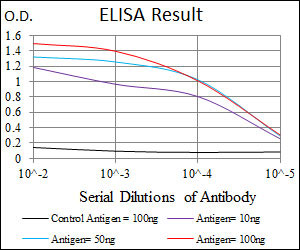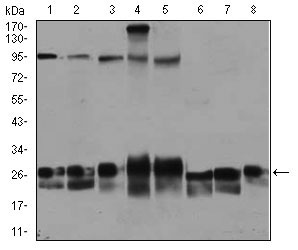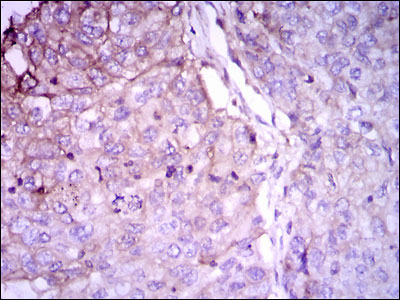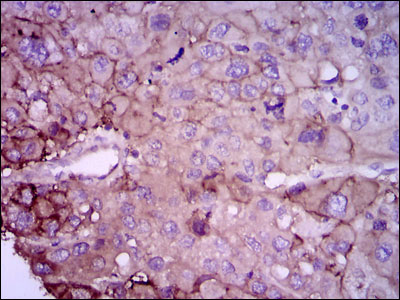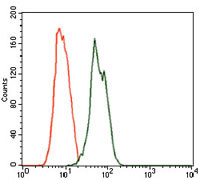RAB4A Antibody
Purified Mouse Monoclonal Antibody
- SPECIFICATION
- CITATIONS
- PROTOCOLS
- BACKGROUND

Application
| WB, IHC, FC, E |
|---|---|
| Primary Accession | P20338 |
| Reactivity | Human, Mouse, Monkey |
| Host | Mouse |
| Clonality | Monoclonal |
| Clone Names | 4E11 |
| Isotype | IgG1 |
| Calculated MW | 23.8kDa |
| Description | The protein encoded by this gene belongs to the rab family. Rab4A protein is involved in the regulation of procathepsin L secretion, it was either inhibited by expression of a Rab4A dominant-negative mutant or increased by overexpression of the wild-type Rab4A in human melanoma cells. |
| Immunogen | Purified recombinant fragment of human RAB4A expressed in E. Coli. |
| Formulation | Purified antibody in PBS with 0.05% sodium azide |
| Gene ID | 5867 |
|---|---|
| Other Names | Ras-related protein Rab-4A, RAB4A, RAB4 |
| Dilution | WB~~1/500 - 1/2000 IHC~~1/200 - 1/1000 FC~~1/200 - 1/400 E~~1/10000 |
| Storage | Maintain refrigerated at 2-8°C for up to 6 months. For long term storage store at -20°C in small aliquots to prevent freeze-thaw cycles. |
| Precautions | RAB4A Antibody is for research use only and not for use in diagnostic or therapeutic procedures. |
| Name | RAB4A (HGNC:9781) |
|---|---|
| Synonyms | RAB4 |
| Function | The small GTPases Rab are key regulators of intracellular membrane trafficking, from the formation of transport vesicles to their fusion with membranes. Rabs cycle between an inactive GDP-bound form and an active GTP-bound form that is able to recruit to membranes different sets of downstream effectors directly responsible for vesicle formation, movement, tethering and fusion (PubMed:15907487, PubMed:16034420). RAB4A is involved in protein transport (PubMed:29425100). Also plays a role in vesicular traffic. Mediates VEGFR2 endosomal trafficking to enhance VEGFR2 signaling (PubMed:29425100). Acts as a regulator of platelet alpha-granule release during activation and aggregation of platelets (By similarity). |
| Cellular Location | Membrane; Peripheral membrane protein. Cytoplasm Early endosome membrane {ECO:0000250|UniProtKB:P05714}; Peripheral membrane protein {ECO:0000250|UniProtKB:P05714}. Recycling endosome membrane {ECO:0000250|UniProtKB:P05714}; Peripheral membrane protein {ECO:0000250|UniProtKB:P05714}. Note=Generally associated with membranes. Cytoplasmic when phosphorylated by CDK1 |

Thousands of laboratories across the world have published research that depended on the performance of antibodies from Abcepta to advance their research. Check out links to articles that cite our products in major peer-reviewed journals, organized by research category.
info@abcepta.com, and receive a free "I Love Antibodies" mug.
Provided below are standard protocols that you may find useful for product applications.
References
1. Biochem J. 2011 Jul 1;437(1):97-107. 2. Int J Cancer. 2011 Jan 1;128(1):192-205.
If you have used an Abcepta product and would like to share how it has performed, please click on the "Submit Review" button and provide the requested information. Our staff will examine and post your review and contact you if needed.
If you have any additional inquiries please email technical services at tech@abcepta.com.













 Foundational characteristics of cancer include proliferation, angiogenesis, migration, evasion of apoptosis, and cellular immortality. Find key markers for these cellular processes and antibodies to detect them.
Foundational characteristics of cancer include proliferation, angiogenesis, migration, evasion of apoptosis, and cellular immortality. Find key markers for these cellular processes and antibodies to detect them. The SUMOplot™ Analysis Program predicts and scores sumoylation sites in your protein. SUMOylation is a post-translational modification involved in various cellular processes, such as nuclear-cytosolic transport, transcriptional regulation, apoptosis, protein stability, response to stress, and progression through the cell cycle.
The SUMOplot™ Analysis Program predicts and scores sumoylation sites in your protein. SUMOylation is a post-translational modification involved in various cellular processes, such as nuclear-cytosolic transport, transcriptional regulation, apoptosis, protein stability, response to stress, and progression through the cell cycle. The Autophagy Receptor Motif Plotter predicts and scores autophagy receptor binding sites in your protein. Identifying proteins connected to this pathway is critical to understanding the role of autophagy in physiological as well as pathological processes such as development, differentiation, neurodegenerative diseases, stress, infection, and cancer.
The Autophagy Receptor Motif Plotter predicts and scores autophagy receptor binding sites in your protein. Identifying proteins connected to this pathway is critical to understanding the role of autophagy in physiological as well as pathological processes such as development, differentiation, neurodegenerative diseases, stress, infection, and cancer.
